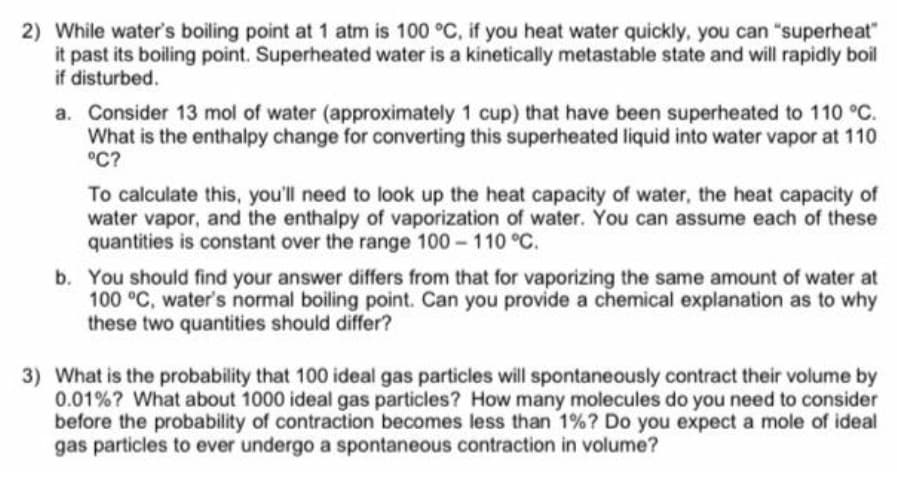2) While water's boiling point at 1 atm is 100 °C, if you heat water quickly, you can "superheat" it past its boiling point. Superheated water is a kinetically metastable state and will rapidly boil if disturbed. a. Consider 13 mol of water (approximately 1 cup) that have been superheated to 110 °C. What is the enthalpy change for converting this superheated liquid into water vapor at 110 °C? To calculate this, you'll need to look up the heat capacity of water, the heat capacity of water vapor, and the enthalpy of vaporization of water. You can assume each of these quantities is constant over the range 100-110 °C. b. You should find your answer differs from that for vaporizing the same amount of water at 100 °C, water's normal boiling point. Can you provide a chemical explanation as to why these two quantities should differ?
2) While water's boiling point at 1 atm is 100 °C, if you heat water quickly, you can "superheat" it past its boiling point. Superheated water is a kinetically metastable state and will rapidly boil if disturbed. a. Consider 13 mol of water (approximately 1 cup) that have been superheated to 110 °C. What is the enthalpy change for converting this superheated liquid into water vapor at 110 °C? To calculate this, you'll need to look up the heat capacity of water, the heat capacity of water vapor, and the enthalpy of vaporization of water. You can assume each of these quantities is constant over the range 100-110 °C. b. You should find your answer differs from that for vaporizing the same amount of water at 100 °C, water's normal boiling point. Can you provide a chemical explanation as to why these two quantities should differ?
Principles of Modern Chemistry
8th Edition
ISBN:9781305079113
Author:David W. Oxtoby, H. Pat Gillis, Laurie J. Butler
Publisher:David W. Oxtoby, H. Pat Gillis, Laurie J. Butler
Chapter12: Thermodynamic Processes And Thermochemistry
Section: Chapter Questions
Problem 42P
Related questions
Question
Please give answer all questions with explanation

Transcribed Image Text:2) While water's boiling point at 1 atm is 100 °C, if you heat water quickly, you can "superheat"
it past its boiling point. Superheated water is a kinetically metastable state and will rapidly boil
if disturbed.
a. Consider 13 mol of water (approximately 1 cup) that have been superheated to 110 °C.
What is the enthalpy change for converting this superheated liquid into water vapor at 110
°C?
To calculate this, you'll need to look up the heat capacity of water, the heat capacity of
water vapor, and the enthalpy of vaporization of water. You can assume each of these
quantities is constant over the range 100 110 °C.
b. You should find your answer differs from that for vaporizing the same amount of water at
100 °C, water's normal boiling point. Can you provide a chemical explanation as to why
these two quantities should differ?
3) What is the probability that 100 ideal gas particles will spontaneously contract their volume by
0.01%? What about 1000 ideal gas particles? How many molecules do you need to consider
before the probability of contraction becomes less than 1%? Do you expect a mole of ideal
gas particles to ever undergo a spontaneous contraction in volume?
Expert Solution
This question has been solved!
Explore an expertly crafted, step-by-step solution for a thorough understanding of key concepts.
This is a popular solution!
Trending now
This is a popular solution!
Step by step
Solved in 3 steps with 2 images

Knowledge Booster
Learn more about
Need a deep-dive on the concept behind this application? Look no further. Learn more about this topic, chemistry and related others by exploring similar questions and additional content below.Recommended textbooks for you

Principles of Modern Chemistry
Chemistry
ISBN:
9781305079113
Author:
David W. Oxtoby, H. Pat Gillis, Laurie J. Butler
Publisher:
Cengage Learning

Chemistry: The Molecular Science
Chemistry
ISBN:
9781285199047
Author:
John W. Moore, Conrad L. Stanitski
Publisher:
Cengage Learning

Chemistry
Chemistry
ISBN:
9781305957404
Author:
Steven S. Zumdahl, Susan A. Zumdahl, Donald J. DeCoste
Publisher:
Cengage Learning

Principles of Modern Chemistry
Chemistry
ISBN:
9781305079113
Author:
David W. Oxtoby, H. Pat Gillis, Laurie J. Butler
Publisher:
Cengage Learning

Chemistry: The Molecular Science
Chemistry
ISBN:
9781285199047
Author:
John W. Moore, Conrad L. Stanitski
Publisher:
Cengage Learning

Chemistry
Chemistry
ISBN:
9781305957404
Author:
Steven S. Zumdahl, Susan A. Zumdahl, Donald J. DeCoste
Publisher:
Cengage Learning


Chemistry: An Atoms First Approach
Chemistry
ISBN:
9781305079243
Author:
Steven S. Zumdahl, Susan A. Zumdahl
Publisher:
Cengage Learning

Chemistry: Principles and Practice
Chemistry
ISBN:
9780534420123
Author:
Daniel L. Reger, Scott R. Goode, David W. Ball, Edward Mercer
Publisher:
Cengage Learning